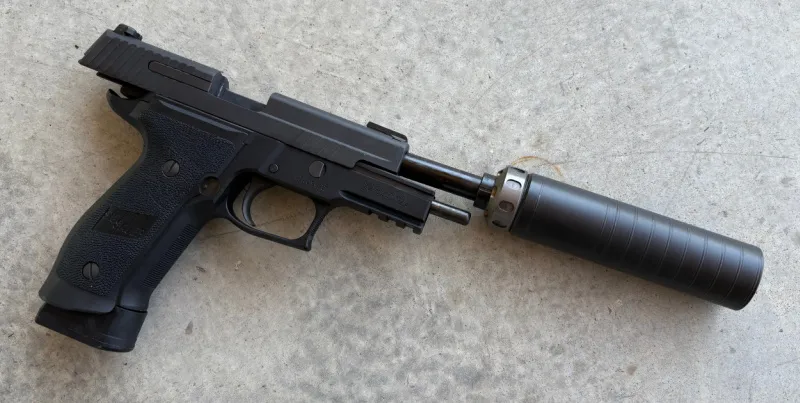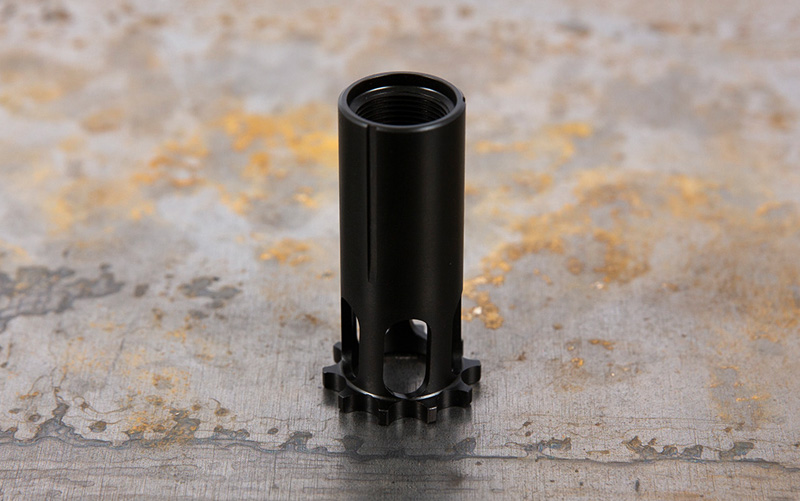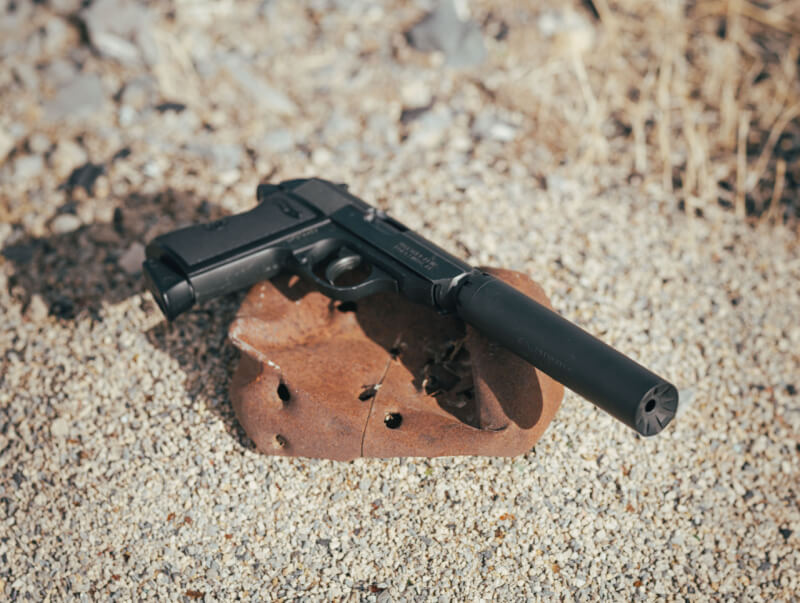[[“value”:”
Thank you for reading this post, don't forget to follow and signup for notifications!
David Higginbotham
Depending on where you’re from, or maybe what circles you run in, you may already be familiar with the term Nielson Device. You may have heard them called muzzle boosters, which is more descriptive than Nielsen Device, or you may have heard them called pistons. A SilencerCo piston is the main component of a Nielsen Device.
What is a Nielsen Device?
A Nielsen Device is an add-on part that helps most semi-automatic pistols cycle when a suppressor is attached. Also known as a muzzle booster or piston, it ensures pistols with tilting barrels function normally under recoil.

Why is a Nielsen Device Necessary?
A Nielsen Device is necessary because, without it, most semi-automatic pistols with tilting barrels won’t cycle reliably when a suppressor is attached. The added weight of the suppressor disrupts the timing of the recoil-operated action, preventing the slide and barrel from separating as designed. The Nielsen Device temporarily decouples that weight during recoil, allowing the pistol to function normally.
The suppressor itself will still quiet the shot, but the pistol may fail to eject, misfeed, or not cycle at all. In effect, the gun becomes a single-shot. The piston doesn’t make the suppressor work—it makes the gun work, keeping suppressed handguns reliable.
To understand why, it helps to know how a semi-automatic pistol operates.

When a pistol is fired, expanding gases drive the bullet forward while also pushing the barrel and slide rearward. In most modern handguns, the two remain locked together for a fraction of a second before the barrel disengages and tips upward, allowing the slide to continue rearward. This motion ejects the spent case, cocks the hammer, and compresses the recoil spring. When the spring expands again, the slide returns forward, chambers a new round, and the cycle repeats.
Most short-recoil operated handguns are tuned to the weight of their factory barrels. Adding the mass of a suppressor upsets that balance, keeping the barrel from moving freely enough to cycle. The Nielsen Device offsets this added weight so the action can run as designed.

The Nielsen Device Adds Movement
Let’s continue to look at the pairing analytically. On one side, you will have a handgun with a threaded barrel. On the other side, you will have a suppressor. If one is joined to the other with a fixed mount, one that doesn’t allow movement, the system may not function as intended.
The Nielsen Device acts as a transitional coupling that allows the action to cycle despite the added weight.

How Does a Nielsen Device Work?
Inside the Nielsen Device, a spring and piston capture some of the gases released when a round is fired. This gas pressure drives the suppressor body forward while pushing the firearm rearward, offsetting the suppressor’s weight and allowing the barrel and slide to cycle properly.
The device itself is comprised of three main parts:
The Piston: This is the part that threads onto the barrel of the handgun. It’s the central component that moves back and forth.
The Spring: The spring is the key to the device. It provides the necessary resistance and returns the suppressor to its original position after the shot.
The Housing: This is the part of the suppressor that holds the spring and piston, allowing the suppressor to temporarily move independently of the barrel.
When the gun fires, the recoil drives the barrel rearward, however momentarily. The suppressor, which is held in place by inertia, stays right in place. The barrel and slide should travel back as intended, compressing the Nielsen Device’s spring along the length of the piston. Then the recoil spring on the gun will return all of the firearm’s parts to their original position, and the Nielsen Device’s spring will force the suppressor back into its alignment.
Which Guns Need a Nielsen Device to Work With a Suppressor?
Most, but not all, semi-automatic handguns need a Nielsen Device. If the barrel tilts or moves, you need a Nielsen Device. Fixed barrel pistols don’t. If the barrel tips up when you lock back the slide, it is safe to say you should have a Nielsen Device built in or added to your suppressor.

Which Guns Don’t Need a Nielsen Device?
Pistons should only be used on moving or tilting barrels. Using a piston with a spring on a fixed-barreled pistol or revolver (or rifle, even) will create a jackhammer effect on the piston. This can damage the piston or the threads on your barrel.
If the barrel stays in place (like on a Walther PPK or many rimfire pistols), you wouldn’t want for the suppressor to move. The same goes for rotary barrels.

Does the Piston Change the Way a Pistol Feels?
Oddly enough, I think it does. My first suppressor was a SilencerCo Sparrow. I still shoot it more than a decade later, mostly from an old Browning Buckmark. That big .22 LR pistol is stable as a table, has a nice long barrel, and the Sparrow (as its name implies) adds very little weight to the end of the gun. No Nielsen Device needed. Even with hot .22 LR, it shoots flat.
As I began shooting suppressed 1911s, and 9mms, I noticed a dramatic change. I’ll begin by saying that I shoot a GLOCK 19 relatively flat. I can hold the recoil down and hold back the slide’s return to stay on target reliably for follow-up shots.
With a Nielsen Device, there’s a change in the feel of a 9mm’s recoil. The gun moves up with recoil, but the extra weight pulls down.
The path to a follow-up shot takes on an S-shaped curve when viewed from the side. The pistol and suppressor would recoil up, dip down, and then I’d pull it back to center. The harder I tried to hold down the recoil, the more I’d dip below.
The trick for me was to relax a bit and let the motion correct itself. By not fighting the recoil, I stopped dipping below my sight line and leveled off. There’s a learning curve. Roll with it, figuratively speaking, and you’ll master the motion.
Final Thoughts on the Nielsen Device
Some suppressors are purpose-built for use with handguns. For instance, the Osprey 2.0 has a piston housing built into it. (Keep in mind, the Osprey 2.0 does not come with a piston. You will need to add it.)
Other suppressors, like the Omega 36M, will have a Nielsen Device as an optional part.

SilencerCo’s pistons are the way to go for anyone looking to suppress a wide range of handguns. They are available in a wide range of thread pitches from 1/2×28 to M16x1 LH, for compatibility with most firearms platforms.
There’s nothing sexy about thread pitches. Pistons will work with many SilencerCo suppressors, though. You may end up ignoring the science behind the Nielsen Device, and you may never call it by its name, but you can’t escape some of the numbers.
David Higginbotham
The post What is a Nielsen Device? appeared first on SilencerCo.
“]]



